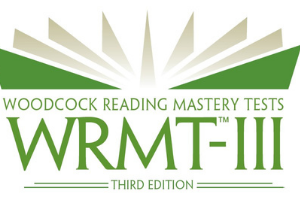Description
Woodcock Reading Mastery Tests Third Edition (WRMTTM-III) retains the format and structure of its predecessor while expanding the test’s range to offer you even more diagnostic capability.

Woodcock Reading Mastery Tests Third Edition (WRMTTM-III) retains the format and structure of its predecessor while expanding the test’s range to offer you even more diagnostic capability.
Woodcock Reading Mastery Tests Third Edition (WRMTTM-III) retains the format and structure of its predecessor while expanding the test’s range to offer you even more diagnostic capability.
Richard W. Woodcock, EdD
Overview:An individual assessment of reading skills for children and adults
Age Range:Ages 4:6 – 79:11; Grades K–12
Administration:Paper-and-pencil
Scoring Option:Q-global™ web-based or Manual scoring
RTI Tiers:RTI Levels 2 and 3
Scores/Interpretation:Standard scores, percentile ranks, age and grade equivalents, Relative Performance Index (RPI), Growth Scale Value (GSV); Cluster scores for Total Reading, Readiness, Basic Skills, Reading Comprehension
Publication Date:2011
The new WRMT-III offers you the latest revision of the WRMT, which set the standard for assessment of reading readiness and reading achievement. This significant revision retains the format and structure of the WRMT-R/NU, while expanding the test’s range to give you even greater diagnostic power.
The WRMT-III helps:
The WRMT-III contains four new and five revised subtests:
The WRMT-III offers significant enhancements, including:
The standardization of the WRMT–III was conducted from July 2009 through June 2010 on a nationally representative sample of 3,360 individuals aged 4 years 6 months through 79 years 11 months. Of this sample, 2,600 individuals were enrolled in school (kindergarten through Grade 12), and their data were used for the grade norms. Tests were administered at more than 1,000 sites in 45 states.
The WRMT-III tests were compared to the WRMT-R/NU, KTEA-II, WIAT-III, WJ-III, CTOPP, and RFI tests. These studies are important for establishing the similarities between scores obtained on the WRMT-III tests and those of other commonly used reading tests and for providing support for convergent evidence of the WRMT-III tests and measures of reading achievement.
Q-global™ Web-based Administration, Scoring, and Reporting – Enables you to quickly assess and efficiently organize examinee information, generate scores, and produce accurate comprehensive reports all via the Web.
The first option is to pay per-report. Customers who administer the WRMT-III only a few times each year, or those who want the flexibility to pay only as the assessment is used, may prefer this option.
The second option is to select an “unlimited use” subscription, where one user of the WRMT-III gets unlimited scoring and reporting for one, three, or five years depending on the selected term of the subscription. This may be a better option for customers who administer the WRMT-III several times each year—and don’t want to worry about keeping track of their report expenses.
View these brief training modules about Q-global:

Presenter: Tina Eichstadt and Adam Scheller

Overview
Five webinars about dyslexia held in 2016-2017 were attended by 6,591 SLPs, psychologists, and special educators. Webinar data offered insights into practitioners’ perspectives on dyslexia training needs and role clarification in practice settings. Presenters will discuss results, which suggests gaps between best practices in dyslexia and reports from individuals engaging in clinical practice.
Learner Outcomes
After the completion of the webinar, participants will be able to:
Time-ordered Agenda
1:00 to 1:05 pm – Introduction and overview
1:05 to 1:30 pm – Practitioner roles in dyslexia
1:30 to 1:55 pm – Practitioner knowledge and skills
1:55 to 2:00 pm – Conclusions and Wrap Up

This course is offered for 0.1 ASHA CEUs (Intermediate level, Professional area.)
Date: Feb 07, 2018
![]() PDF: Educational Practice in Dyslexia: Professional Roles and Knowledge Gaps
PDF: Educational Practice in Dyslexia: Professional Roles and Knowledge Gaps
![]() Video: Educational Practice in Dyslexia: Professional Roles and Knowledge Gaps
Video: Educational Practice in Dyslexia: Professional Roles and Knowledge Gaps
Presenter: Adam Scheller

During this webinar, Adam will review relevant research regarding the correlation of oral language acquisition with reading, as well as the key pre‐reading skills necessary for children to become effective readers. We will discuss a process for assessment wand case study using the Oral Language Acquisition Inventory, 2nd edition and Woodcock Reading Master Test, 3rd edition.
Date: Jan 23, 2013
Presenter: Amy Gabel

During this webinar we will investigate a case through the lens of an evaluator from receiving a referral to making recommendations. The case study will incorporate relevant background information, observation findings, previous evaluation results, and current evaluation results. Specific concerns will be addressed in the area of reading, with use of the WRMT-III for advanced analysis. This specific case focuses on addressing the needs of an adolescent who struggles to meet academic challenges in a high school setting.
Date: Nov 08, 2011
Presenter: Amy Gabel

During this webinar, we will describe interpretation of the Woodcock Reading Mastery Test-Third Edition in depth. We will highlight the use of the WRMT-III to investigate reading needs through advanced interpretation of the subtests and Index scores as well as integration of other data. While this webinar will not address administration or basic scoring, we will review specific subtests and the use of the online scoring and reporting system using case data. We will also discuss when further evaluation is indicated based on WRMT-III performance, including what specific information to request. You may want to view the Overview recording before this webinar.
Date: Oct 13, 2011
Presenter: Misty Sprague & Amy Gabel

The Woodcock Reading Mastery Test is newly revised. Coming June 2011! During this 30 minute webinar, the presenter will describe what’s NEW in the WRMT-III. We will also discuss how you can use this test to assist in diagnosing reading difficulties in the areas of reading readiness, basic skills, and comprehension and how to identify specific children’s strengths and weaknesses in reading skills so that you can plan targeted remediation to address the needs of all learners.
Date: Sep 07, 2011